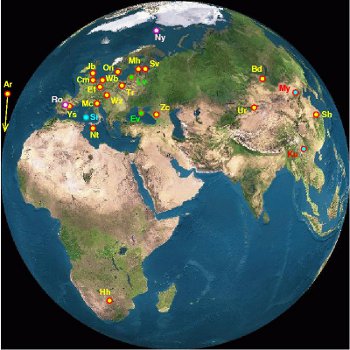
The European VLBI Network (EVN) is an interferometric array of radio telescopes spread throughout Europe and beyond. This image shows existing operational stations (yellow/red), new stations not yet fully participating (blue), non-EVN stations that sometimes participate (purple), and non-EVN stations with whom initial EVN-tests have been carried out (green/brown). Observations are also often conducted in conjuction with the VLBA, GBT, and/or VLA telescopes in the U.S. (not shown). Telescopes operated from Jodrell Bank are indicated by Jb (the Lovell and/or Mark II telescopes) and Cm (the Cambridge telescope). The underlying map was generated from EarthView. Credit: JIVE.
NEXPReS - European developments in advanced techniques for radio astronomy
21 July 2010
The European Commission has awarded the Novel Explorations Pushing Robust e-VLBI Services project (NEXPReS) 3.5 million euros to advance data transfer, buffering, storage and distributed computing technologies. The improvements are expected to significantly enhance electronic Very Long Baseline Interferometry (e-VLBI) services offered by the European VLBI Network (EVN) to the entire radio astronomy community and, it is hoped, to benefit science research infrastructure across a range of fields. This work is part of the EVN's "e-EVN Programme" of e-VLBI developments, officially recognised as a SKA Pathfinder Technology for its anticipated impact on the Square Kilometre Array (SKA), as well as the recently inaugurated LOw Frequency Array (LOFAR).
VLBI is an astronomical method by which multiple radio telescopes located hundreds or thousands of kilometres apart observe the same region of sky simultaneously. Data from each telescope is recorded onto hard disks which are shipped to a central "correlator", a purpose-built supercomputer which processes the data. This simulates a single telescope with a diameter as wide as the most distantly located telescopes and produces images with higher resolution than the most powerful optical telescopes.
In the United Kingdom several radio telescopes (including the 76-metre Lovell Telescope at Jodrell Bank Observatory and other telescopes which make up the e-MERLIN network) regularly take part in VLBI observations as part of the European VLBI Network. These UK telescopes are operated by the University of Manchester's Jodrell Bank Centre for Astrophysics on behalf of the Science and Technology Facilities Council (STFC).
e-VLBI improves upon the traditional disk-based method by streaming data directly from the telescopes and correlating it in real-time, currently at a rate of one Gigabit per second (Gbps) from each telescope, and eventually tens of Gbps. e-VLBI's speed allows personnel to immediately identify and correct problems during an observation, and delivers data to astronomers in a matter of hours rather than weeks. If so-called transient activity is detected, such as a supernova or gamma-ray burst, the astronomer can quickly schedule additional observations, an advantage not possible with traditional VLBI. Jodrell Bank was a founding member of the European VLBI Network and has helped to pioneer these new techniques in real-time VLBI.
NEXPReS aims to implement the "best of both worlds" - data archiving and reprocessing afforded by traditional disk-based VLBI with the speed and flexibility of e-VLBI - through a variety of improved technologies and processes:
- Buffering mechanisms - real-time caching of terabytes of data per observation to address data transfer bottlenecks
- Distributed correlation - an automated, distributed correlator to replace the single supercomputer currently used
- High-bandwidth, high-capacity networked storage on demand - distributed storage capable of handling tremendous data requirements
- High bandwidth on demand - encourage the adoption of dynamic networking technologies across independently operated networks used for e-VLBI
NEXPReS is a three year project with a start date of 1 July 2010.
About NEXPReS
Novel Explorations Pushing Robust e-VLBI Services (NEXPReS) is a three-year project funded by the European Commissionís Seventh Framework Programme (FP7) with the goal of implementing real-time, electronic VLBI (e-VLBI) into all observations conducted by the European VLBI Network. This will be achieved through development of a variety of technologies including: cloud correlation; high-bandwidth on demand; distributed correlation; and high-bandwidth, high-capacity networked storage on demand. NEXPReS is comprised of 15 partner institutes (including the University of Manchester's Jodrell Bank Centre for Astrophysics) in eleven countries and is coordinated by JIVE.
About JIVE
The Joint Institute for VLBI in Europe (JIVE) is a scientific foundation with a mandate to support the operations of the European VLBI Network (EVN). For this purpose it maintains, operates and develops the MKIV EVN Data Processor, a powerful supercomputer that combines the signals from radio telescopes located across the planet.
Through this technique, called Very Long Baseline Interferometry (VLBI), astronomers can make detailed images of cosmic radio sources, providing astronomers with the clearest, highest resolution view of some of the most distant and energetic objects in the Universe.
Contact
Huib Jan van Langevelde, Director
Joint Institute for VLBI in Europe
+31 (0)521 596524
langevelde@jive.nl
T. Charles Yun, Project Manager
Joint Institute for VLBI in Europe
+31 (0)521 596537
tcyun@jive.nl


